-
 Bitcoin
Bitcoin $85,618.5384
2.96% -
 Ethereum
Ethereum $1,640.2124
5.21% -
 Tether USDt
Tether USDt $0.9997
0.03% -
 XRP
XRP $2.1632
7.34% -
 BNB
BNB $597.1208
1.93% -
 Solana
Solana $132.8194
9.58% -
 USDC
USDC $0.9999
-0.01% -
 Dogecoin
Dogecoin $0.1676
5.63% -
 TRON
TRON $0.2466
2.33% -
 Cardano
Cardano $0.6579
6.01% -
 UNUS SED LEO
UNUS SED LEO $9.3558
0.64% -
 Chainlink
Chainlink $13.1471
4.65% -
 Avalanche
Avalanche $20.4796
7.96% -
 Stellar
Stellar $0.2473
5.87% -
 Sui
Sui $2.3384
7.44% -
 Hedera
Hedera $0.1756
5.28% -
 Shiba Inu
Shiba Inu $0.0...01252
3.40% -
 Toncoin
Toncoin $2.9499
4.76% -
 Bitcoin Cash
Bitcoin Cash $340.5254
9.00% -
 MANTRA
MANTRA $6.2672
-2.89% -
 Litecoin
Litecoin $78.6729
3.87% -
 Polkadot
Polkadot $3.7183
4.58% -
 Hyperliquid
Hyperliquid $16.7994
10.67% -
 Dai
Dai $1.0001
0.03% -
 Bitget Token
Bitget Token $4.4320
2.74% -
 Pi
Pi $0.7326
16.74% -
 Ethena USDe
Ethena USDe $0.9991
0.04% -
 Monero
Monero $210.4897
0.60% -
 Uniswap
Uniswap $5.4973
5.84% -
 OKB
OKB $54.8064
3.33%
What are algorithmic stablecoins? How do they maintain anchoring?
Algorithmic stablecoins use algorithms to maintain a stable value, typically pegged to the US dollar, by adjusting token supply in response to market conditions.
Apr 12, 2025 at 11:35 am
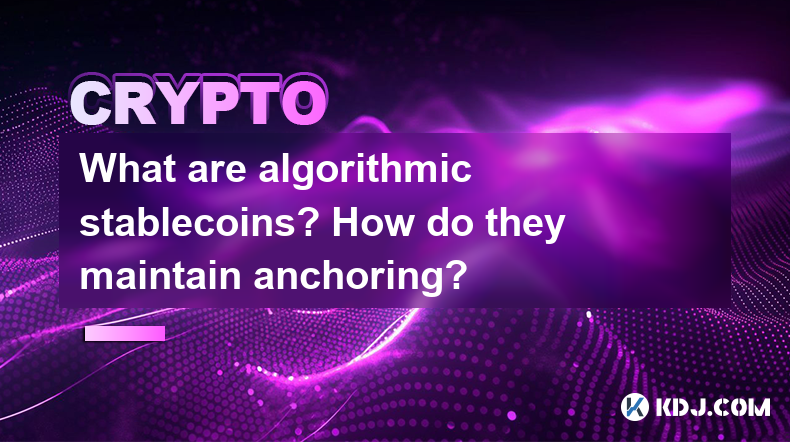
Algorithmic stablecoins represent a fascinating and innovative segment within the cryptocurrency ecosystem. These digital assets are designed to maintain a stable value, typically pegged to a fiat currency like the US dollar, through the use of algorithms rather than traditional collateral. This approach distinguishes them from other types of stablecoins, such as those backed by physical assets or fiat reserves. In this article, we will delve into the mechanics of algorithmic stablecoins, exploring how they maintain their anchoring and the various methods they employ to achieve stability.
Understanding Algorithmic Stablecoins
Algorithmic stablecoins are a type of cryptocurrency that uses algorithms to manage their supply and demand, thereby maintaining a stable value. Unlike collateralized stablecoins, which are backed by assets like fiat currency or other cryptocurrencies, algorithmic stablecoins rely solely on the power of code to adjust their supply in response to market conditions. This method aims to keep the stablecoin's value pegged to a target, usually a fiat currency like the US dollar.
The concept behind algorithmic stablecoins is rooted in the idea that by dynamically adjusting the supply of the token, it is possible to counteract fluctuations in demand and maintain a stable price. This is achieved through various mechanisms, which we will explore in detail in the following sections.
Types of Algorithmic Stablecoins
There are several types of algorithmic stablecoins, each employing different strategies to maintain their peg. The most common types include:
- Rebase Stablecoins: These stablecoins adjust the total supply of tokens held by each user periodically, either increasing or decreasing the number of tokens to maintain the peg.
- Seigniorage Style Stablecoins: These stablecoins use a dual-token system, where one token is the stablecoin itself, and the other is a governance or bond token used to manage the supply of the stablecoin.
- Fractional Algorithmic Stablecoins: These stablecoins combine algorithmic mechanisms with partial collateralization, using a mix of algorithms and reserves to maintain stability.
Each type of algorithmic stablecoin has its own unique approach to maintaining the peg, and understanding these differences is crucial for grasping how they function.
How Rebase Stablecoins Maintain Anchoring
Rebase stablecoins operate by periodically adjusting the total supply of tokens in circulation. This process, known as "rebase," can either increase or decrease the number of tokens each holder possesses, depending on whether the stablecoin's value is above or below the target peg.
- If the stablecoin's value is above the peg, the rebase mechanism will increase the total supply, diluting the value of each token and bringing the price back down to the target.
- Conversely, if the stablecoin's value falls below the peg, the rebase mechanism will decrease the total supply, increasing the value of each token and pushing the price back up to the target.
This dynamic adjustment of supply helps rebase stablecoins maintain their anchoring to the target value, typically the US dollar. The frequency of rebases can vary, with some stablecoins adjusting daily and others less frequently.
Seigniorage Style Stablecoins and Their Mechanism
Seigniorage style stablecoins employ a more complex mechanism involving a dual-token system. This system consists of the stablecoin itself and a secondary token, often referred to as a governance or bond token.
- When the stablecoin's value is above the peg, the protocol issues new stablecoins and sells them in exchange for the secondary token. This increases the supply of the stablecoin, pushing its value back down to the peg.
- When the stablecoin's value falls below the peg, the protocol buys back and burns the stablecoins using the secondary token. This decreases the supply of the stablecoin, pushing its value back up to the peg.
The secondary token plays a crucial role in managing the supply of the stablecoin, and its value can fluctuate based on the demand for the stablecoin. This system allows seigniorage style stablecoins to maintain their anchoring through a more intricate balance of supply and demand.
Fractional Algorithmic Stablecoins and Their Approach
Fractional algorithmic stablecoins combine the algorithmic approach with partial collateralization. These stablecoins use a mix of algorithms and reserves to maintain their peg, offering a hybrid solution that aims to leverage the strengths of both methods.
- The algorithmic component of fractional stablecoins adjusts the supply of tokens in response to market conditions, similar to other algorithmic stablecoins.
- The collateralized component provides a buffer of reserves, typically in the form of other cryptocurrencies or fiat currency, which can be used to stabilize the stablecoin's value if the algorithmic adjustments are insufficient.
This hybrid approach allows fractional algorithmic stablecoins to maintain their anchoring by balancing the flexibility of algorithms with the security of collateral. The exact ratio of algorithmic to collateralized components can vary, depending on the specific design of the stablecoin.
Challenges and Risks of Algorithmic Stablecoins
While algorithmic stablecoins offer an innovative approach to maintaining stability, they are not without challenges and risks. Some of the key issues include:
- Volatility: Algorithmic stablecoins can be susceptible to rapid price fluctuations if the algorithms fail to adjust the supply effectively.
- Complexity: The mechanisms used by algorithmic stablecoins can be complex and difficult to understand, potentially leading to user confusion and mistrust.
- Regulatory Uncertainty: The regulatory environment for algorithmic stablecoins is still evolving, which can pose risks for both issuers and users.
Understanding these challenges is essential for anyone considering the use of algorithmic stablecoins, as they can impact the stability and reliability of these digital assets.
Frequently Asked Questions
Q: Can algorithmic stablecoins be used for everyday transactions?
A: Yes, algorithmic stablecoins can be used for everyday transactions, provided they maintain their peg effectively. However, their acceptance depends on merchant adoption and user trust in their stability.
Q: How do algorithmic stablecoins compare to traditional stablecoins in terms of decentralization?
A: Algorithmic stablecoins are generally considered more decentralized than traditional stablecoins, as they do not rely on centralized reserves. However, the effectiveness of their algorithms and the governance structures in place can impact their level of decentralization.
Q: Are there any successful examples of algorithmic stablecoins in the market?
A: Yes, there are several algorithmic stablecoins that have gained traction in the market. Examples include Ampleforth (AMPL), which uses a rebase mechanism, and Basis Cash (BAC), which employs a seigniorage style approach. These stablecoins have demonstrated varying degrees of success in maintaining their pegs.
Q: What happens if an algorithmic stablecoin fails to maintain its peg?
A: If an algorithmic stablecoin fails to maintain its peg, it can lead to significant volatility and loss of confidence among users. In such cases, the stablecoin's value may deviate from the target, and users may seek to exit their positions, further exacerbating the instability.
Disclaimer:info@kdj.com
The information provided is not trading advice. kdj.com does not assume any responsibility for any investments made based on the information provided in this article. Cryptocurrencies are highly volatile and it is highly recommended that you invest with caution after thorough research!
If you believe that the content used on this website infringes your copyright, please contact us immediately (info@kdj.com) and we will delete it promptly.
- XRP is trading at $2.07 with a market capitalization of $117 billion and a global 24-hour trade volume of $3.65 billion.
- 2025-04-13 10:10:12
- As April Unfolds, MAGACOINFINANCE Emerges as a Contender Alongside XRP, BTC, ETH, and SOL
- 2025-04-13 10:10:12
- Bitcoin (BTC), XRP, and Solana Are Winning Over Analysts. But There's a New Kid in Town.
- 2025-04-13 10:05:12
- Pi Coin Gains Traction in South Korea and the US, Targeting Everyday Transactions
- 2025-04-13 10:05:12
- Dogecoin (DOGE) Value: Holding on or Heading Down?
- 2025-04-13 10:00:12
- Solana (SOL) Sees Massive Token Unlock From FTX/Alameda, Raising Doubts About Market Performance Despite Recent Price Hike
- 2025-04-13 10:00:12
Related knowledge
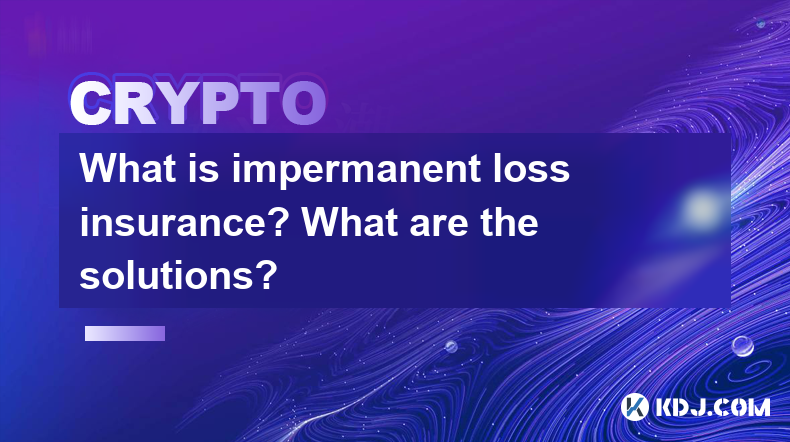
What is impermanent loss insurance? What are the solutions?
Apr 12,2025 at 01:14am
What is Impermanent Loss Insurance? What are the Solutions? Impermanent loss is a significant concern for liquidity providers in decentralized finance (DeFi) platforms. It occurs when the price of tokens in a liquidity pool changes compared to when they were deposited, leading to a potential loss if the provider decides to withdraw their liquidity. To m...

What are algorithmic stablecoins? How do they maintain anchoring?
Apr 12,2025 at 11:35am
Algorithmic stablecoins represent a fascinating and innovative segment within the cryptocurrency ecosystem. These digital assets are designed to maintain a stable value, typically pegged to a fiat currency like the US dollar, through the use of algorithms rather than traditional collateral. This approach distinguishes them from other types of stablecoin...
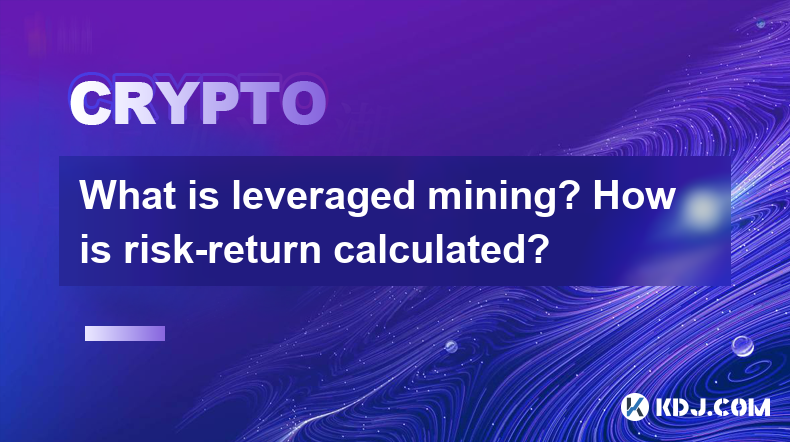
What is leveraged mining? How is risk-return calculated?
Apr 11,2025 at 04:07pm
What is Leveraged Mining? How is Risk-Return Calculated? Leveraged mining is a strategy used in the cryptocurrency space where miners borrow funds to increase their mining capacity and potential returns. This approach can amplify both profits and losses, making it a high-risk, high-reward endeavor. Understanding how to calculate the risk and return asso...
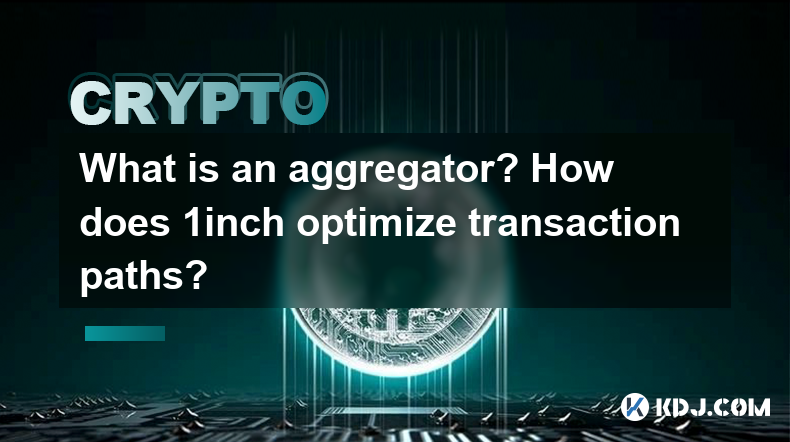
What is an aggregator? How does 1inch optimize transaction paths?
Apr 12,2025 at 05:00pm
An aggregator in the cryptocurrency space is a tool that compiles and compares data from multiple decentralized exchanges (DEXs) to find the best possible trading routes and prices for users. Aggregators are essential for traders looking to optimize their transactions, as they can automatically search through various liquidity sources to ensure the most...
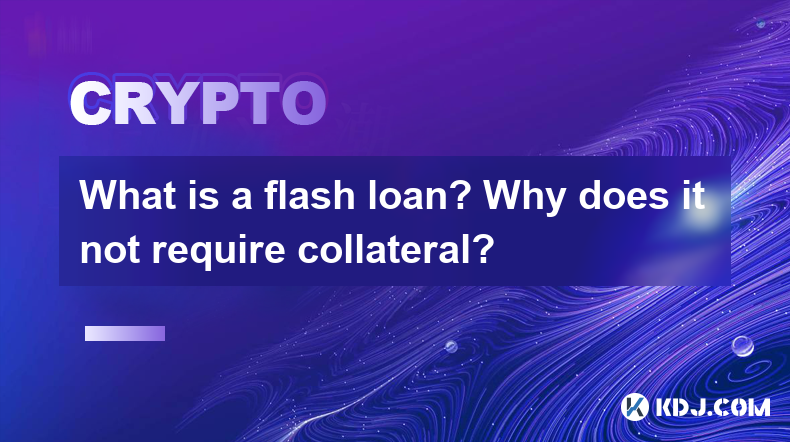
What is a flash loan? Why does it not require collateral?
Apr 11,2025 at 12:57pm
A flash loan is a type of loan that is unique to the decentralized finance (DeFi) ecosystem. It allows borrowers to take out a loan without the need for collateral, and the loan must be repaid within the same transaction. This type of loan is facilitated by smart contracts on blockchain platforms, most commonly on the Ethereum network. The concept of a ...
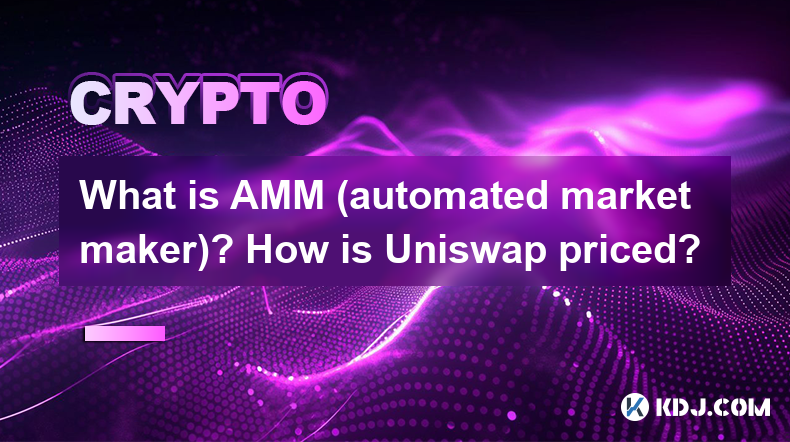
What is AMM (automated market maker)? How is Uniswap priced?
Apr 11,2025 at 06:57pm
What is AMM (Automated Market Maker)? How is Uniswap Priced? Automated Market Makers (AMMs) are a type of decentralized exchange protocol that use algorithms to price assets instead of traditional order books. The most well-known AMM is Uniswap, which has become a cornerstone of the decentralized finance (DeFi) ecosystem. This article will delve into th...

What is impermanent loss insurance? What are the solutions?
Apr 12,2025 at 01:14am
What is Impermanent Loss Insurance? What are the Solutions? Impermanent loss is a significant concern for liquidity providers in decentralized finance (DeFi) platforms. It occurs when the price of tokens in a liquidity pool changes compared to when they were deposited, leading to a potential loss if the provider decides to withdraw their liquidity. To m...

What are algorithmic stablecoins? How do they maintain anchoring?
Apr 12,2025 at 11:35am
Algorithmic stablecoins represent a fascinating and innovative segment within the cryptocurrency ecosystem. These digital assets are designed to maintain a stable value, typically pegged to a fiat currency like the US dollar, through the use of algorithms rather than traditional collateral. This approach distinguishes them from other types of stablecoin...

What is leveraged mining? How is risk-return calculated?
Apr 11,2025 at 04:07pm
What is Leveraged Mining? How is Risk-Return Calculated? Leveraged mining is a strategy used in the cryptocurrency space where miners borrow funds to increase their mining capacity and potential returns. This approach can amplify both profits and losses, making it a high-risk, high-reward endeavor. Understanding how to calculate the risk and return asso...

What is an aggregator? How does 1inch optimize transaction paths?
Apr 12,2025 at 05:00pm
An aggregator in the cryptocurrency space is a tool that compiles and compares data from multiple decentralized exchanges (DEXs) to find the best possible trading routes and prices for users. Aggregators are essential for traders looking to optimize their transactions, as they can automatically search through various liquidity sources to ensure the most...

What is a flash loan? Why does it not require collateral?
Apr 11,2025 at 12:57pm
A flash loan is a type of loan that is unique to the decentralized finance (DeFi) ecosystem. It allows borrowers to take out a loan without the need for collateral, and the loan must be repaid within the same transaction. This type of loan is facilitated by smart contracts on blockchain platforms, most commonly on the Ethereum network. The concept of a ...

What is AMM (automated market maker)? How is Uniswap priced?
Apr 11,2025 at 06:57pm
What is AMM (Automated Market Maker)? How is Uniswap Priced? Automated Market Makers (AMMs) are a type of decentralized exchange protocol that use algorithms to price assets instead of traditional order books. The most well-known AMM is Uniswap, which has become a cornerstone of the decentralized finance (DeFi) ecosystem. This article will delve into th...
See all articles
























































































